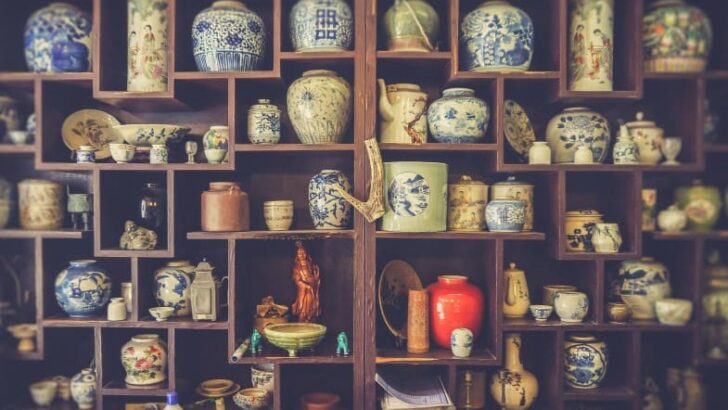Your cart is currently empty!
How to Tell How Old Pottery Is – 5 Ways to Date Pottery
Published:
Last Updated:

Affiliate Disclaimer
As an affiliate, we may earn a commission from qualifying purchases. We get commissions for purchases made through links on this website from Amazon and other third parties.
It is not always easy to tell how old pottery is. In fact, it requires years of practice and significant expertise to accurately guess the age of pottery by just looking at it. It is especially difficult to determine the age of very ancient pieces as they rarely have markings, unlike those made during and after the 20th Century.
There are several techniques to determine how old a piece of pottery is. One way to date pottery is to test it with carbon-14 or optically stimulated luminescence. There is also a kind of pottery age determination where fragments are compared with other known objects whose ages are already known in order to determine relative age.
This method is referred to as relative dating. This article will look at these techniques and more that are used to measure the age of pottery.

Some Ways to Tell How Old Pottery Is
Here are five of the most common ways to tell how old pottery is…
1) Carbon Dating/Radiocarbon Dating/ 14 C Dating
The radiocarbon dating method is a popular method used to determine the age of ancient objects that have organic materials. With this method, scientists have accurately placed the age of clay-based pottery pieces.
The method revolves around an isotope of carbon, C-14, which has a half-life of 5730 years. The half-life of an isotope refers to the number of years it takes to lose half of its radioactivity.
Carbon 14 is constantly incorporated into the atmosphere and is incorporated into different life forms through the carbon cycle. Scientifically, an older carbon-14 sample has less radiocarbon.
This dating method has been used by scientists to date pottery in archaeological studies. However, it has proven inconsistent and inaccurate a lot of times, thereby not giving the best results.
One primary reason for this inefficiency is that most organic materials in pottery are not likely to survive oxidation while cooking on a fire.
Therefore, scientists have come up with ways to make the method more accurate and reliable. For instance, they have focused on dating palmitic and stearic acids that are absorbed by uncovered kitchenware. For this, scientists use residual fats that remain after the preparation of food.
The researchers obtain two fatty acids through gas chromatography and then look for carbon-14 content in mass spectrometry. Scientists would verify this method using the dendrochronological data-dating method to enhance accuracy.
The 14 C dating method can be used for dating pottery that is up to 8000 years old accurately and is widely used in Europe and Africa.
2) Relative Dating
Relative dating is another way to tell how old pottery is. It is used to estimate the age of an object compared to other similar items whose ages are known. With this method, a piece of pottery could either be older or younger than the determinant object.
An example of relative dating that is usually used to determine the age of pottery is the seriation method. The seriation method can be described as ordering artifacts according to their age.
Seriation involves determining the ages of pieces of pottery by analyzing their abundances through time. This is achieved by counting the number of pieces of each style of artifact in every stratigraphic layer and representing the data using a graph.
A layer with many pieces will form a thick band on the graph, and similarly, a layer with few pieces will form a narrow band.
These bands are then arranged into curves where each gets its own curve. This means that the thick band will have its own curve, and the thin one its own curve. At this point, a comparison of the curves happens, and the relative ages of the pottery styles are determined.
The main limitation to this relative dating method is that it is not always accurate. This is because it’s assumed that different pottery styles are from different time periods. However, this does not factor in the possibility that some styles may have been a result of the immigration of new cultures in the area under study.
3) Thermoluminescence Dating
In this method of pottery dating, electrons from the minerals found in the clay, such as quartz, are exposed to radiation and bumped from their normal positions. These minerals should be photosensitive for this method to work. There are two sources of radiation for this process: cosmic radiation or radioactive substances found in the clay, such as uranium.
The piece of pottery in question is heated to more than 500 degrees Celsius- at which the electrons are ground.
At this stage, the electrons emit light, resetting the clock of the pottery to zero, a process known as clock setting. Essentially, the longer the radiation, the more electrons are displaced, and the more emitted light.
Scientists can determine the age of the ceramic, that is since it was fired, by heating it and measuring the amount of light given off.
To achieve this, researchers expose the ground electrons, otherwise called grains, to a known amount of light and compare it to the unknown sediment. With this method, scientists can determine the age of sediments that are less than 500,000 years old.
The main advantage of this method is that it covers the time interval between radiocarbon and potassium-argon dating, which is between 40,000 to 200,000 years. Also, the thermoluminescence method can be used in dating materials that can’t be dated using radiocarbon or potassium-argon dating.
The downside to this method is that exposing the sediment to be tested to light may result in inaccuracy and inconsistency. This is because exposure leads to clock setting, making the process more challenging.
4) Use of Markings to Tell How Old Pottery Is
Markings are common in pottery made after the 1900s. Most of these ceramics have the word “patented” inscribed at the bottom. Those made in France would use the word ‘depose’ which translates to “registered.”
Additionally, some pieces of pottery would have the phrase “made in” and the name of the country of origin, such as pieces of Van Briggle Pottery.
Many pieces made after 1915 can be identified by the phrase “bone china.” If you’d like to know more about how to identify bone china, you can check out this article that I wrote on exactly that topic here.
After 1930, many ceramic pieces would come with instructional markings such as “detergent proof,” “dishwasher proof,” or “ovenproof”. This was to indicate that it was safe to use detergents, dishwashers, and ovens with these pieces of pottery, respectively.
While it was relatively rare, some ceramics would have the inscription “craze proof”. This was to indicate that the piece could resist the unattractive crackle pattern that usually forms because of fluctuations in temperature and humidity.
Starting from the 1960s, many pieces of writing would have the writing “microwave proof” because, at this time, microwaves had started becoming a household item in many places around the world. So, if you find a ceramic with these writings, you know that they were made during the 20th Century.
5) How Ceramics React With Moisture In The Air
This method is primarily used on fired clay ceramics such as bricks, pottery, tiles. The team that discovered this method hailed from the University of Manchester and the University of Edinburgh.
The credibility of the method was established when the team dated brick samples from Roman, medieval, and modern times with astounding accuracy.
As per researchers, this method can be used to date ceramics that are 10,000 years old or more. Further research is undergoing to determine whether this method can be used to determine the age of pieces made of china, earthenware, and porcelain.
The science behind this method is based on the fact that clay ceramics begin to react with moisture in the air immediately after they are removed from a kiln after firing. The piece of clay pottery then continues to react with moisture throughout its lifetime, causing it to become heavier with time.
So, a sample is first weighed then heated to 500 degrees Celsius to get rid of the combined water. At this point, it is weighed again to record its weight without moisture. Then, it is exposed to air moisture again, and its weight gain is measured over a couple of days.
The weight gained by the sample over the days provides data needed to calculate the amount of time the sample needs to acquire its original weight, revealing its age.
How to Tell an Antique from a Faux?
Faux ceramics are those that are made to look like the real ones, the antiques. Faux actually means false.
Usually, faux pieces of pottery are disguised as antiques by making them look older than they actually are. The disguise could be in the form of painting the bottom of the faux ceramic brown to achieve an ‘ancient’ look. At times, it is not easy to tell a faux from an antique unless you consult an expert.
However, there is a way you can determine whether ceramic is original faux or an antique. First, turn the piece over to see the bottom and check the kind of clay it is made of. Then using a clean cloth, wipe the bottom of the ceramic thoroughly. If it is dusty and dirty, then it is antique. If it is relatively clean, then you have a faux piece of pottery.
Final Thoughts
There are several techniques used to tell how old pottery is. Pottery is one of the oldest artifacts around, and some of them are up to 10000 years old, and others are even older than that. Different techniques have time limits to which they can date an object.
Carbon dating is one of the most common ways to tell how old pottery is and has an accuracy level of 8000 years. Other methods include relative dating, thermoluminescence dating, and the use of markings.



